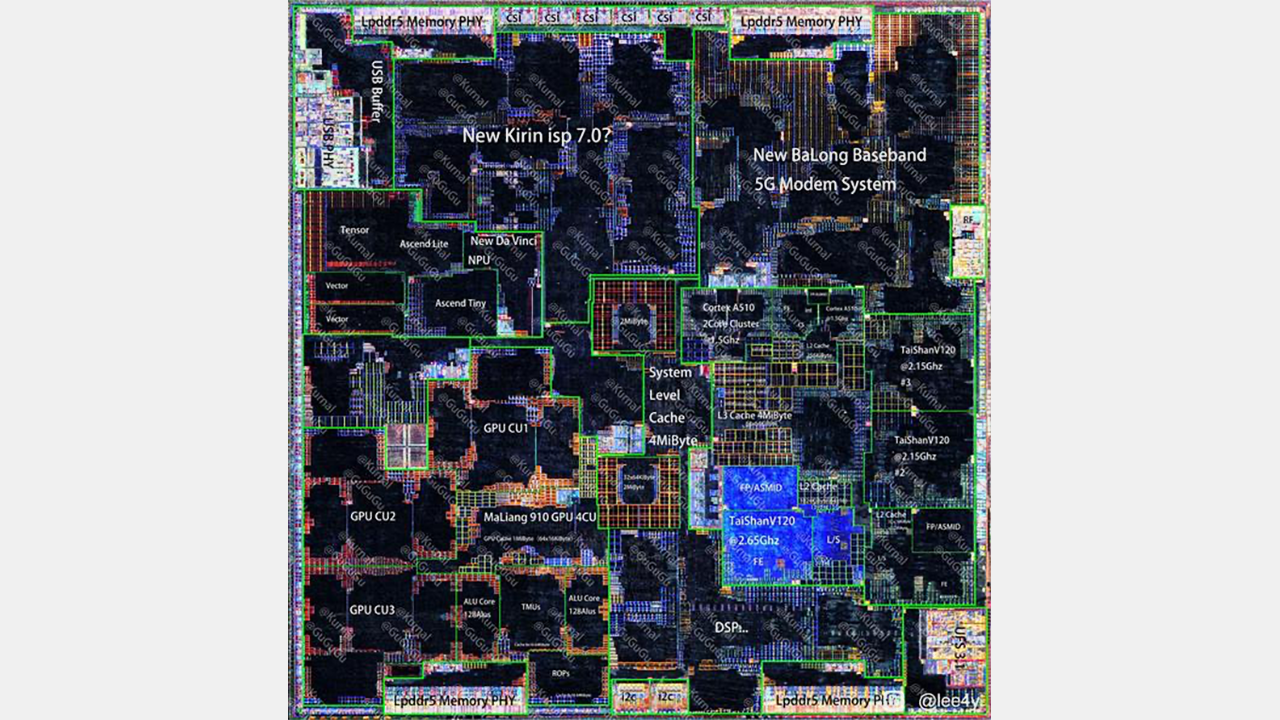Die Shot of HiSilicon's Sanction-Busting Kirin 9000s Chip Revealed
HiSilicon's Kirin 9000s die shot may reveal some of its secrets.

The first die shot of Huawei's HiSilicon Kirin 9000s system-on-chip (SoC) published at Baidu reveals a monolithic die with a massive 5G modem, a huge image signal processor (ISP), a new neural processing unit (NPU) and custom CPU and GPU cores. Huawei's Kirin 9000S system-on-chip powers Huawei's new Mate 60 Pro smartphone. The chip is made by China-based SMIC using its 2nd generation 7nm-class process and stacking, then provided to Huawei in violation of US sanctions.
Huawei’s HiSilicon Kirin 9000S SoC is a rather intricate SoC with four high-performance Taishan V120 cores and four Arm Cortex A510 energy-efficient cores (in two dual-core clusters), which shows that developers decided to take a different approach than Apple and packed more high-performance cores and fewer energy-efficient cores. By contrast, Apple's A17 Pro features two performance and four efficient cores. The SoC also features a quad-cluster Mailiang 910 GPU, which reportedly operates at a maximum clock of 750 MHz. While we do not have official information about the architecture that powers the GPU, Huawei likely uses Arm's Mali technology for its GPU.
While the CPU and GPU cores take up a substantial portion of Kirin 9000S's die size, it is noteworthy that the SoC also packs a large 5G modem and a huge ISP to enable advanced imaging capabilities.
According to TechInsights, the application processor is made on SMIC's 2nd Generation 7nm process technology, and it is a bit surprising that Huawei decided to integrate a modem rather than spend more die area on additional CPU and GPU capabilities.
Back in the day, Huawei's HiSilicon arm was known as a leading designer of smartphone system-on-chips that challenged application processors from Apple, Qualcomm, and Samsung. Because of the U.S. sanctions against Huawei, HiSilicon lost access to leading-edge production at TSMC, and the company had to put advanced SoC development on pause for a few years as it needed to wait for China-based SMIC to develop technologies comparable to those from TSMC.
As it turns out, the company not only released a rather interesting SoC with a novel approach to integrate more high-performance cores and fewer energy-efficient cores, but it has also managed to pack in a 5G modem, a chip that could be made separately to improve yields.
Get Tom's Hardware's best news and in-depth reviews, straight to your inbox.

Anton Shilov is a contributing writer at Tom’s Hardware. Over the past couple of decades, he has covered everything from CPUs and GPUs to supercomputers and from modern process technologies and latest fab tools to high-tech industry trends.
-
2+2 In the old days it was a Cold War,Reply
now it's a Chip War.
Nothing wrong with staying informed with where everyone is at. -
tstager According to multiple sources, this chip isn't what it seems to be, much like everything else in China.Reply -
2+2 Reply
It doesn't have to be better than Apple,tstager said:According to multiple sources, this chip isn't what it seems to be, much like everything else in China.
it just has to do a good enough job
when Apple phones are not available. -
atomicWAR I would be impressed IF I knew for a fact their was no stolen IP in the chip (not a political view but chip design/manufacturing one). But if history is any indication than their is likely ill gotten IP onboard. We won't know until it drops though. I reserve judgment in the mean timeReply -
InvalidError Looks like the USA's China ban sparked some seemingly spectacular domestic progress over there.Reply -
photon123 Reply
Any idea about density of this, as well as densities for Intel 4,2,A18? The problem is that these are just commercial node names, and they can call it whatever they want.peachpuff said:7nm? China ahead of intel? omg... -
Co BIY Replyphoton123 said:Any idea about density of this, as well as densities for Intel 4,2,A18? The problem is that these are just commercial node names, and they can call it whatever they want.
The technical specs are not that important, what really matters is the performance of the end product. (and cost) -
aer4af "Huawei's Kirin 9000S system-on-chip powers Huawei's new Mate 60 Pro smartphone. The chip is made by China-based SMIC using its 2nd generation 7nm-class process and stacking, then provided to Huawei in violation of US sanctions."Reply
Can anybody explain why a domestic company based in China offering services "within" China has violated a law in a foreign country? -
BlackWhiteX Reply
The US is alleging that SMIC would have been unable to manufacture the chip without the use of new UV Lithography machines, which are proprietary tech of US based companies. The US government therefore is saying they violated/circumvented trade restrictions because SMIC is banned from purchasing that technology from US suppliers.aer4af said:"Huawei's Kirin 9000S system-on-chip powers Huawei's new Mate 60 Pro smartphone. The chip is made by China-based SMIC using its 2nd generation 7nm-class process and stacking, then provided to Huawei in violation of US sanctions."
Can anybody explain why a domestic company based in China offering services "within" China has violated a law in a foreign country?